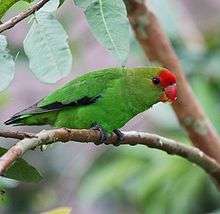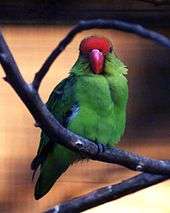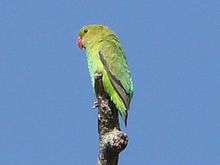Black-winged lovebird
The black-winged lovebird (Agapornis taranta) also known as Abyssinian lovebird is a mainly green bird of the parrot family. At about 16.5 cm (6.5 inches) long, it is the largest of the lovebird genus, a group of small parrots. The adult male is easily identified by its red forehead, and the adult female by its all green head.[2] They are native to Eritrea and Ethiopia,[1] and they are uncommon as pets.[3]
| Black-winged lovebird | |
|---|---|
.jpg) | |
| Female (left) and male (right) | |
| Scientific classification | |
| Kingdom: | Animalia |
| Phylum: | Chordata |
| Class: | Aves |
| Order: | Psittaciformes |
| Family: | Psittaculidae |
| Genus: | Agapornis |
| Species: | A. taranta |
| Binomial name | |
| Agapornis taranta (Stanley, 1814) | |
Description

The black-winged lovebird, with a length of about 16[3]–16.5[2] cm (6.25–6.5 inches), is the largest of all the lovebirds. It is sexually dimorphic, as are the red-headed lovebird and grey-headed lovebird of the lovebird genus. The dimorphism becomes apparent in juvenile birds after their first molt at about eight or nine months of age. Both the male and female black-winged lovebird are mostly green, and only the adult male black-winged lovebird has a red forehead and a ring of red feathers around its eyes.[2]
The tail is black tipped and feathers below the tail show a yellowish colour. The rump and feathers above the tail are light green. In the male feathers under the wing are typically black, and in the female the feathers under the wing are typically greenish or brownish black. Both sexes have a red beak and gray feet.
Habitat
The natural habitat for a black-winged lovebird is typically from southern Eritrea to southwestern Ethiopia and they normally live in either high plains or mountainous regions.[4]
Behavior


Food and feeding
Sunflower seeds, corn, apples and mission figs are typical of an Abyssinian lovebird diet.
Status
Widespread and a common species throughout its habitat range, the black-winged lovebird is evaluated as Least Concern on the IUCN Red List of Threatened Species.[1]
Aviculture
In aviculture the black-winged lovebird has not become well established as a breeding bird, although it can tolerate cold weather. Breeding in aviculture is on a small scale, so it is an uncommon pet.[3]
References
- BirdLife International (2012). "Agapornis taranta". IUCN Red List of Threatened Species. 2012. Retrieved 26 November 2013.CS1 maint: ref=harv (link)
- Le Breton, Kenny (1992). Lovebirds...getting started. USA: T.F.H. Publications. pp. 88–89. ISBN 0-86622-411-4.
- Alderton, David (2003). The Ultimate Encyclopedia of Caged and Aviary Birds. London, England: Hermes House. p. 219. ISBN 1-84309-164-X.
- Aerts, R.; Lerouge, F.; November, E. (2019). Birds of forests and open woodlands in the highlands of Dogu'a Tembien. In: Nyssen J., Jacob, M., Frankl, A. (Eds.). Geo-trekking in Ethiopia's Tropical Mountains - The Dogu'a Tembien District. SpringerNature. ISBN 978-3-030-04954-6.
- "Species factsheet: Agapornis taranta". BirdLife International (2008). Retrieved 9 July 2008.
